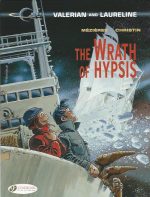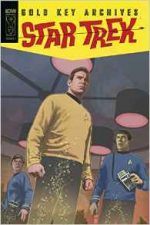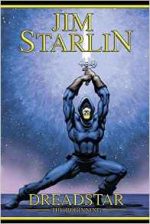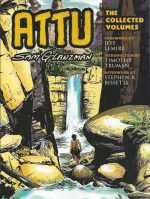
By Méziéres & Christin, with colours by Evelyn Tranlé; translated by Jerome Saincantin (Cinebook)
ISBN: 978-1-84918-304-8
Valérian: Spatio-Temporal Agent debuted in weekly Pilote #420 (9th November 1967) and was an instant smash-hit. The feature soon became Valérian and Laureline as his feisty distaff sidekick rapidly developed into an equal partner and scene-stealing star through a string of fabulously fantastical, winningly sly and light-hearted time-travelling, space-warping romps.
Packed with cunningly satirical humanist action, challenging philosophy and astute political commentary, the stellar yarns struck a chord with the public and especially other creators who have been swiping, “homaging†and riffing off the series ever since.
Initially Valerian was an affably capable yet unimaginatively by-the-book space cop tasked with protecting the official universal chronology (at least as it affects humankind) by counteracting and correcting paradoxes caused by incautious time-travellers.
When he travelled to 11th century France in debut tale Les Mauvais Rêves (Bad Dreams and still not yet translated into English), he was rescued from doom by a tempestuously formidable young woman named Laureline whom he had no choice but to bring back with him to Galaxity: the 28th century super-citadel and administrative capital of the Terran Empire.
The indomitable female firebrand crash-trained as an operative and accompanied him on subsequent missions – a beguiling succession of breezy, space-warping, social conscience-building epics. This so-sophisticated series always had room to propound a satirical, liberal ideology and agenda (best summed up as “why can’t we all just get along?â€), constantly launching telling fusillades of commentary-by-example to underpin an astounding cascade of visually appealing, visionary space operas.
The Wrath of Hypsis is the twelfth Cinebook translation: concluding a landmark tale and marking a turning point in the ongoing epic. Initially every Valérian adventure began as a serial in Pilote before being collected in album editions, but after this adventure from 1985, the publishing world shifted gears. From the next tale and every one thereafter, the mind-bending sagas were released as all-new complete graphic novels. The switch in dissemination affected all popular characters in French comics and almost spelled the end of periodical publication on the continent…
(One clarifying note: in the canon, “Hypsis†is counted as the twelfth tale, due to the collected albums being numbered from The City of Shifting Waters: the second actual story but the first to be compiled in book form. When Bad Dreams was finally released as a European album in 1983, it was given the number #0.)
Les Foudres d’Hypsis originally appeared in then-monthly Pilote #M128-135, spanning January to September 1985: an action-packed trenchant romp that reset a growing paradox that had been slowing building since The City of Shifting Waters…
In previous volume The Ghosts of Inverloch the immensity of Galaxity was eradicated from reality by agents unknown, leaving only the Chief of the Spatio-Temporal Service to plunge back in time to 1986: the chronal crisis-point which triggered the disaster.
Spatio-Temporal partners-in-peril Valerian and Laureline joined him by extremely convoluted paths after gathering a trio of Shingouz traders and Ralph – an affable aquatic super-mathematician – from different eras and galactic backwaters.
They all rendezvoused at Inverloch Castle, far from escalating petty crises and a mounting unrest afflicting Earth which would peak with the melting of the polar ice-caps, destruction of modern human civilisation and consequent birth-pangs of Galaxity.
The Scottish citadel was home to British intelligence supremo Lord Seal, his brilliant wife Lady Charlotte and her current guest Mr. Albert: Galaxity’s volubly jolly, infuriatingly unrushed and always tardy 20th century information gatherer/sleeper agent.
This distinguished, exceptional band had gathered to prevent Earth’s devastation but Galaxity’s sudden disappearance added even greater urgency to the mission…
The tale continues here as the strange crew review the worsening situation. Nuclear powers across the planet are experiencing inexplicable and potentially fatal malfunctions. Alien objects keep appearing in random locations and – thanks to the extraterrestrial input of Seals visitor’s – they can lay the blame upon the machinations of Hypsis: an enigmatic planet which constantly perambulates from system to system, quadrant to quadrant…
Seal’s contacts have narrowed down the potential crisis point to one of a number of ships in the Arctic. Soon the odd allies are covertly heading north in British weather ship HMS Crosswinds…
Thanks to Ralph’s talents and growing friendship with a pod of Orcas, the maritime search is gradually narrowed down and before long Crosswinds closes in on a quaint schooner named Hvexdet… and none too soon.
The time-lost Chief has locked himself in his cabin, Valerian is wracked by nightmares of vanished Galaxity and numerous doomed Earths whilst the gambling-addicted Shingouz have almost won or traded everything aboard ship not bolted down or welded on…
Cornering the Hvexdet in a field of pack ice, dauntless Captain Merryweather gives orders to ram, spooking the schooner into blasting off into space and instituting devastating retaliation. It’s what the Chief has been waiting for. With Crosswinds sinking and the crew heading for the lifeboats, he orders Valerian, Laureline, Seal, Albert, the Shingouz and Ralph to join him in the astroship: following the invaders’ flight to find nomadic Hypsis…
Pursuit is erratic and convoluted until Valerian has the idea of linking Ralph to the ship’s systems and predicting Hvexdet’s final destination. The scheme works perfectly and before long the astroship touches down on a strange, rocky world with immense towers dotting the landscape.
And that’s where things get really strange as Valerian learns why Earth was scheduled for nuclear meltdown, meets the incredible true owners of the troubled birthplace of humanity and watches in astonishment as Albert, Laureline and the Shingouz negotiate an unbelievable deal which saves Earth, but not (necessarily) his beloved and much-missed home Galaxity…
Astute fans will realise that this ripping yarn was writer Pierre Christin and artist Jean-Claude Méziéres; way of rationalising the drowned Earth of 1986 (as seen in their 1968 adventure The City of Shifting Waters) with the contemporary period that they were now working in. It also gave them an opportunity to send Valerian and Laureline in a new direction and uncharted creative waters…
To Be Continued…
Smart, subtle, complex and frequently hilarious, this sharp trans-time tale beguilingly blended outrageous satire with blistering action and deft humour with cosmic apostasy to completely reenergise what was already one of the most thrilling sci fi strips in comics. The Wrath of Hypsis is one of the most memorable romps Méziéres & Christin ever concocted, and heralded the start of a whole new way to go back to the future…
© Dargaud Paris, 1985 Christin, Méziéres & Tranlệ. All rights reserved. English translation © 2016 Cinebook Ltd.







 By Jim Starlin (Dynamite Entertainment)
By Jim Starlin (Dynamite Entertainment)
